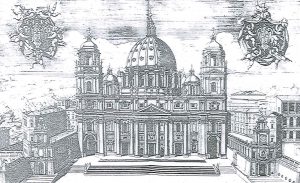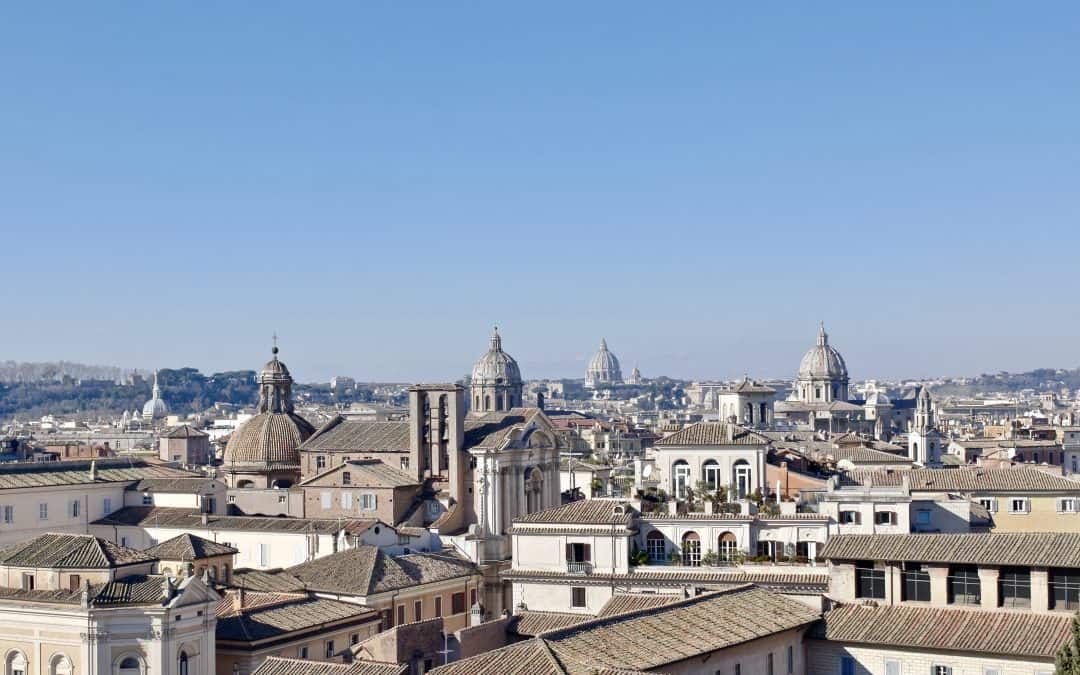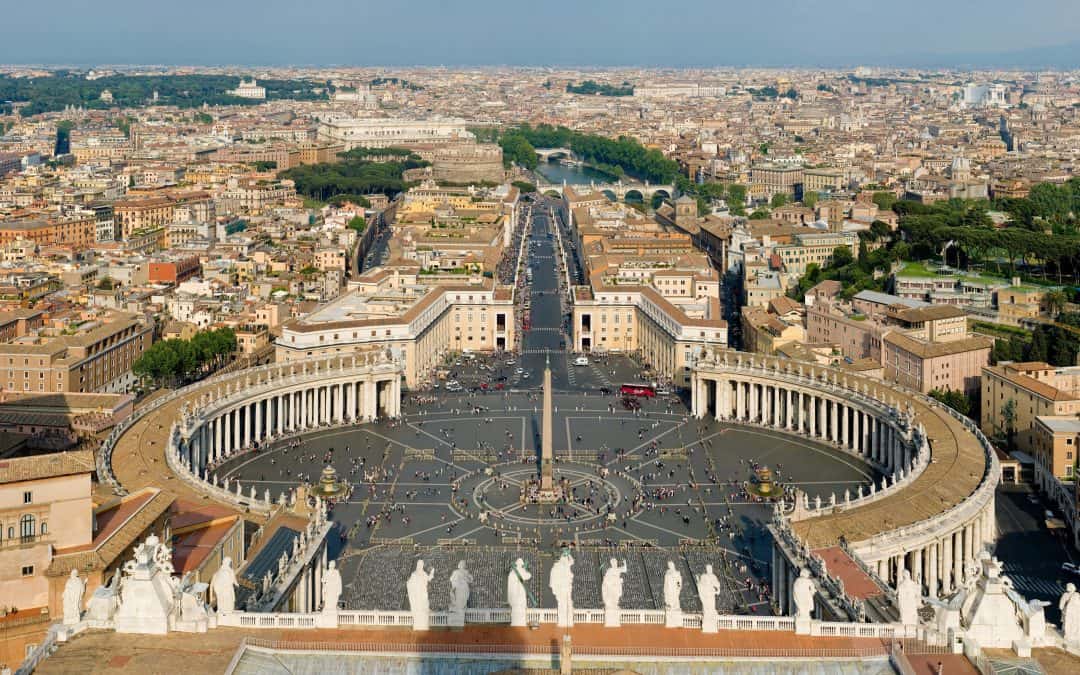
by eduardoalfaro | Dec 14, 2022 | Sistine Chapel, Vatican |
VATICAN CITY STATE
Many visitors coming to Rome have the idea that the Vatican is a city, with streets, shops, houses, etc. , many of them don’t even know that the Vatican is a State. The big question is : what is the Vatican city State?
The Vatican https://roma-bella.com/tours/vatican-city/

- The Vatican is a sovereign country
- The Vaticanhttps://roma-bella.com/tours/vatican-city/ is the smallest country in the world
- The Vatican is not a city, but a territory of 109 acres, the equivalent of 1/8 of Central Park in New York, closed by a wall built in the XVI century
- The population of the Vatican is of 453 people, but only 246 are citizens, amongst them the 104 Swiss guards.
- The Vatican citizens instead are 618. Of them 372 of are dwelling in Italy or other countries.
Why such a particular State?
Everything started in the year 1870 when the Pope Pius IX lost the power of Rome, that was part of the Pontifical State. The Pontifical State was a territory occupying the central part of Italy where the Pope had the political and religious power. On September of 1870 Rome was occupied by the “bersaglieri”: soldiers of the King Victor Emanuel II, and proclaimed Rome Capital of the Reign of Italy. The Pope Pius IX self-exiled in his palace, the Vatican.
In 1929 Italy was a Reign ruled by the dictator Benito Mussolini who had imposed a dictatorship. After several meetings with the Pope Pius XI he announced to the world that the Vatican territory would be recognized as a sovereign country. This territory included St. Peter’s Basilica, St. Peter’s square, the Sistine Chapel, the large Museum created since the 1506 and the Papal palace.


by Ximena Amarales | Sep 11, 2021 | Vatican |
St. Peter’s square https://roma-bella.com/tours/vatican-city/ is undoubtedly one of the most outstanding architectural spaces in Rome. But this astonishing square, as most of the historical sites of the eternal city, “was not built in one day”. Not because its construction lasted 11 years (1656-1667) but because the square is the result of centuries of changes, additions, transformations to the original IV century basilica that in the XVI century had become a chaotic entrance to the Basilica dedicated to the first Pope of Rome: St. Peter.
 In this first 1577 engrave created by the artist Lefrery you can appreciate that the Constantinian basilica (IV century) façade, after centuries of transformations had become an addition of different buildings, hights and styles. In the background is appearing a round volume: is the new St. Peter’s Basilica created by Bramante in the XVI century, conceived with a dome.
In this first 1577 engrave created by the artist Lefrery you can appreciate that the Constantinian basilica (IV century) façade, after centuries of transformations had become an addition of different buildings, hights and styles. In the background is appearing a round volume: is the new St. Peter’s Basilica created by Bramante in the XVI century, conceived with a dome.  On this second 1588-90 engrave by Cesare Nebbia, there is an Egyptian obelisk that creates a certain order in the chaotic space. This obelisk is part of wide urban plan created in Rome by Pope Sixtus V’s architect: Domenico Fontana.
On this second 1588-90 engrave by Cesare Nebbia, there is an Egyptian obelisk that creates a certain order in the chaotic space. This obelisk is part of wide urban plan created in Rome by Pope Sixtus V’s architect: Domenico Fontana.
With the Council of Trent (1545-1563) who produced the counter reform within the catholic church, many new rules were issued, including the artistic ones: the new churches had to transform their layout into the shape of the Latin cross. St. Peter’s basilica who have had a Greek cross layout was extended under Carlo Maderno’s new project. The new façade as a unity was inaugurated in 1612, without the 2 belfries, built some years later (1640) but then demolished.


The breakthrough arrived with the master Gian Lorenzo Bernini who crowned St. Peter’s Basilica with this brilliant creation. He was able to unify all the different inputs around the Basilica: arrival, Papal palace entrance, basilica entrance, proportion, human scale. St. Peter’s square protects and connects the devoted visitors with the Dome, symbol of the kingdom of heaven. The two colonnades are the arms of the church embracing the faithful in an endless gesture of love.


In yellow all the buildings that were demolished to create the square.


Nolli’s plan created in 1748 showing the square before the fascist government intervention to create Via della Conciliazione.

by eduardoalfaro | Dec 19, 2019 | Museums, Rome, Vatican |
3 things you didn’t know about the Vatican Museums in Rome
A must stop for every tourist in Rome, a state inside the city. What am I talking about? It is the Vatican city, of course.
This small country of its own sits right in the middle of the Roman culture, arts and history, with its boundaries enclosed in the – let’s say it – nicest city of the world.
There are many sites one can visit within the siege of the Catholic church: a magnificent square, the porch and the columnade that are called after St Peter, and then again fountains, gardens, statues and many more landmarks. Plenty to choose from and many different itineraries, so that you can come back many times and discovering always different spots.
One amongst all those beautiful places is one that certainly cannot be missed when in Rome: it is the Vatican Museums, showcasing a massive collection of art pieces, historical mementos and ancient objects from different times in history.
There are a million information that you can read about this place, but also a lot of secrets about the Vatican Museums that nobody will tell you about.
No one but me!
Ready to hear some? Here we go.
- Michelangelo’s paintings are not only representing saints or angels.
I am not going fool, don’t worry. The Sistine Chapel is the best example of Michelangelo’s talent and a majestic work of art. The artist was able, together with his crew, to paint over a 5000 square meters ceiling and just over 300 human figures. As you just learned, it was not only saints and angels: many of the humans represented were in fact inspired by people living in Michelangelo’s times. Politicians, lawyers and other important citizens but one stands against them all: did you know that Jesus face in the infamous Giudizio Universale belongs in fact to Tommaso de’ Cavalieri, which was said to be the artist’s lover?!
- There are way more visitors than you would expect
You are getting it right: there are a huge number of tourists visiting the Vatican museums everyday. And the number is increasing year by year.
There are in fact over 27 thousand visitors getting inside the Vatican every single day: just as if a medium-large town will go on a day trip there everyday! Impressive, and crowded of course. You can probably tell once you see the queue at the ticket office. The museums are open every single day (but on Sundays and catholic holidays) since 1771: can you work out how many tickets get sold in a year time?!
- The Museums had some special closing date, which was neither a Sunday or a catholic holiday.
As just mentioned, the Vatican Museums were opened to the public for the first time in 1771 by Pope Clemens XIV and they have been open every day since. Every day but one: curiously, in 1938, Pope Pius XI decided to close the museums exceptionally on a week day. That was the day when Adolf Hitler, dictator from Germany, came to Rome on a visit. The Pope’s intention was to forbid the dictator’s access to such richness and beauty. And in fact he managed to do so.
So, tell me: did you know any of those special secrets about the Vatican Museums?! I bet you didn’t. But I will tell you more: there are a whole bunch of other curiosity about the Vatican City and other must visit spots in Rome I am happy to share with you.
So now you have 2 choices: keep reading this blog or book a customized tour around Rome.
Which one will you pick?

by Ximena Amarales | Jan 22, 2019 | Ancient Rome, Vatican |
Hi Ximena,
Hope you are well!
It’s Amanda (and Terry, Jude and Sol) here from Sydney. We arrived back about a week ago and are settling back into routine and awfully hot humid weather! Finally had a few moments to sit down at the computer so wanted to send you a quick note to thank you very much for your amazing and personal service with the Ancient Rome and Vatican tours we attended with you earlier in January. We all agreed that you were the best guide we had the whole time we were away! Your knowledge and warmth was so appreciated. You were also so patient with the boys and read their behaviour well and tailored everything as needed. Thank you, we loved it!
We all loved the Colosseum tour too even though we didn’t get to see it with you. We were very fortunate that we had a very passionate archaeologist leading our tour who did a great job – and it was perfect having your added insight prior.
Here’s a few photos from the visits – a couple with you, and I apologise to that I don’t think I asked your permission to take these first. I love the view over the rooftops – you took us to the best location for that! It’s great that you can’t see the Piazza Venezia in view like you do from most other locations 😉

by Ximena Amarales | Jun 5, 2018 | Vatican |
Beautiful, stunning, magnificent. There are a million ways to describe Rome, the Eternal city.
Centuries of history, arts and social changes have contributed to building what is today the busy city of Rome.
But wait! This is not just a city, it is an open door museum. And it is very much worth to discover every little corner, every square, every fountain, every palace. That is how you will deeply understand the never-ending cultural features the city has developed.
Today you will join a Vatican City tour – well, not just A tour – this is my special Vatican Tour Rome. A tour that lets you learn about the religious history of Rome and the true meaning behind all artworks.
Not only that: with this tour you will get to skip the lines and enjoy every masterpiece in the Vatican state in just a day!
(more…)
by Ximena Amarales | Jan 30, 2017 | Rome, Vatican |
Associated Press – November 2015
Pope Francis has dismissed a question about whether condoms can be condoned in the fight against Aids by saying there are more important issues confronting the world, like malnutrition, environmental exploitation and the lack of safe drinking water.
Francis was asked about the church’s opposition to condoms while returning Monday to Rome from Kenya, Uganda and the Central Africa Republic, Africa in general and Kenya and Uganda in particular have been hard hit by the Aids epidemic, and the Catholic church has faced criticism that its position has contributed to the problem.
Francis’s predecessor, Pope Benedict XVI, earned the wrath of healthcare professionals, gay rights activists and the United Nations by saying on a visit to Africa that condoms were not the answer to fighting HIV and could actually make it worse.
Francis has made scant reference to Aids in his speeches this past week. He did, however, visit HIV-infected children at a Uganda hospital and kissed each one, listened to moving testimony from a girl born with the virus and thanked the church’s healthcare workers for caring for those infected.
A clearly irked Francis criticized the question directed at him during his in-flight press conference about whether the church should change its position on condoms to limit HIV’s spread. He said it “seems too small, partial”, when there are bigger issues confronting humanity.
“I don’t like getting into questions or reflections that are so technical when people die because they don’t have water or food or housing,” he said.
He said when those problems are taken care of, questions like condoms and Aids can be addressed.
Francis has previously signalled that he doesn’t want to get drawn into culture war issues over contraception or abortion, and his response Monday was very much in line with such comments.
Francis was euphoric, though, about his first trip to Africa, saying he was constantly surprised by the continent and the ability of its people to find joy with so little.
He denounced how Africa has constantly been exploited by foreign powers, citing the slave trade and those who “only look to take Africa’s riches”.
“Africa is a martyr. It’s a martyr of exploitation over history,” he said. “I love Africa for this.”
















